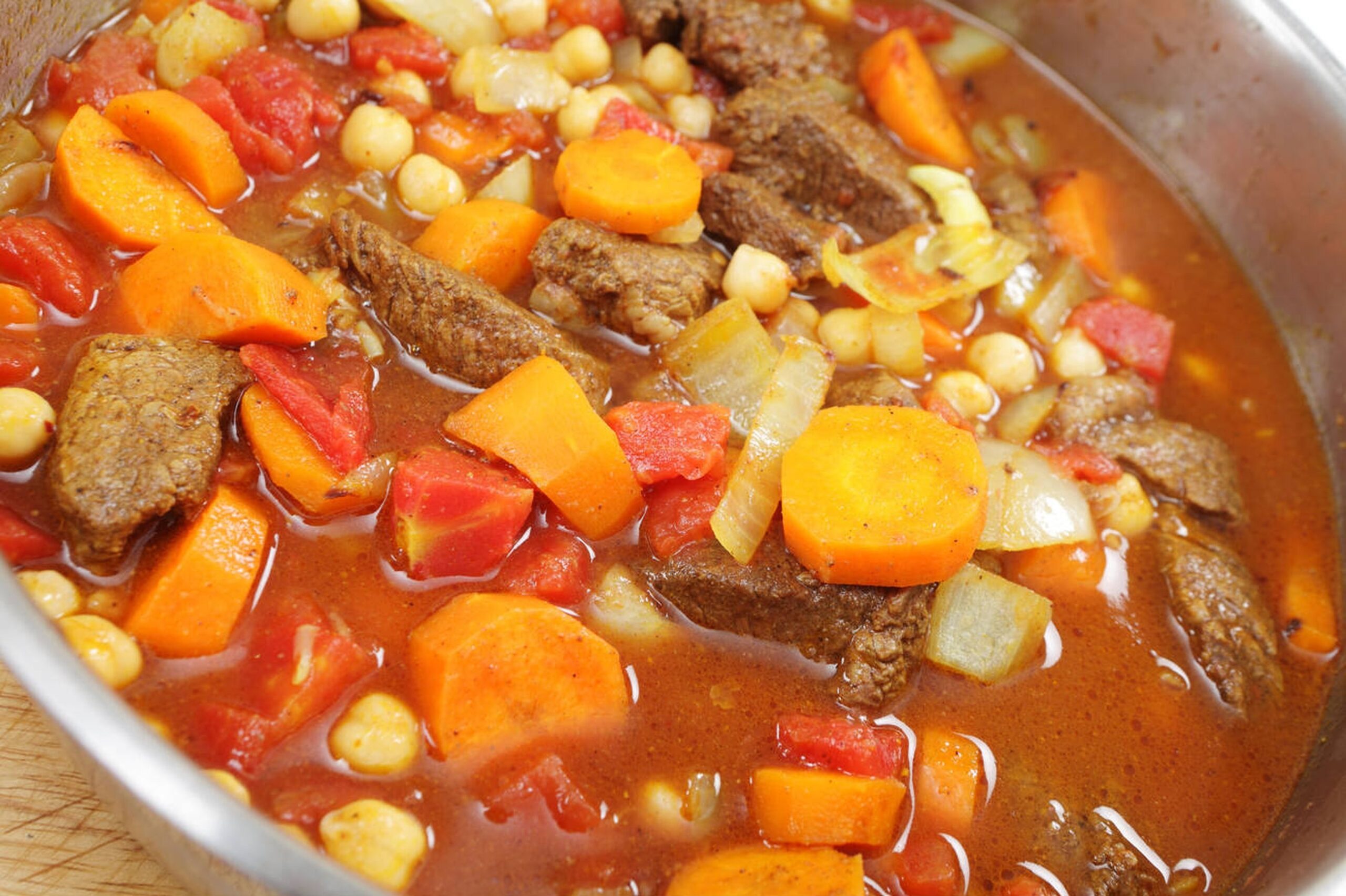Moroccan beef stew with chickpeas is a notable meal that perfectly captures this cooking legacy. Berber, Arab, and Mediterranean civilizations are all reflected in the rich tapestry of flavors, colors, and textures that is Moroccan food.
Ingredients
Beef: Choose a cut suitable for slow cooking, such as chuck or brisket. These cuts become tender and flavorful when simmered.
Chickpeas: Either canned or dried (soaked overnight). Chickpeas add protein and a creamy texture to the stew.
Onions: Finely chopped onions provide a sweet base flavor.
Garlic: Minced garlic enhances the overall aroma and depth of flavor.
Tomatoes: Fresh or canned tomatoes contribute acidity and sweetness.
Carrots: Sliced carrots add natural sweetness and color.
Spices: A blend of cumin, coriander, cinnamon, paprika, and turmeric brings warmth and complexity to the dish.
Herbs: Fresh cilantro or parsley for garnish adds brightness.
Olive oil: For sautéing the vegetables and browning the meat.
Salt and pepper: To taste.
Moroccan Beef Stew with Chickpeas
Preparation Steps
To guarantee that your stew turns out flawlessly, preparation is essential before beginning the cooking process. First, collect all of your ingredients and get them ready as follows:
Beef Preparation: If the beef isn’t already sliced, chop it into bite-sized chunks. To make sure they brown well when cooking, pat them dry with paper towels.
Prepare the chickpeas by soaking them in water for the entire night if you’re using dried chickpeas. This shortens the cooking time and helps them cook more evenly.
How to Prepare Vegetables: Finely chop the onions, mince the garlic, cut the carrots into rounds, and dice the fresh tomatoes if you’re using them.
Spice Blend: To ensure that your spices are ready to use when needed, measure them out in advance.
Lemon Zest: To improve the dish’s freshness, zest one lemon before juicing it.
Cooking Method
After preparing your ingredients, it’s time to combine them in a saucepan that can cook slowly.
Sautéing the Aromatics: In a large pot, heat the olive oil over medium heat. Add the chopped onions and cook for approximately five minutes, or until they are transparent. After that, sauté the minced garlic for one more minute, or until it becomes aromatic.
Browning the Beef: Put the beef cubes in the saucepan and raise the heat to medium-high. For five to seven minutes, brown them on all sides. Because it caramelizes, this phase is essential for developing flavor.
Adding Spices: After the beef has browned, add your spice mixture (turmeric, paprika, cinnamon, coriander, and cumin) and stir thoroughly to cover the meat evenly.
Adding Vegetables: After that, put diced tomatoes and sliced carrots in the saucepan. Mix everything until it’s all properly blended.
Simmering with Liquid: Add enough water or broth (about 4 cups) to cover the ingredients by about 1 inch. Turn the heat down to low after bringing it to a boil. For around one and a half hours, or until the beef is cooked, cover the saucepan and boil it gently.
Adding Chickpeas: Add the dried chickpeas approximately half an hour before the stew is finished cooking, or add the canned chickpeas in the final ten minutes to ensure they are heated thoroughly.
Final Seasoning: As the cooking time comes to a finish, taste your stew and add more salt and pepper if necessary.
Final Touches: Add chopped parsley or cilantro as a garnish and squeeze in fresh lemon juice immediately before serving for extra brightness.
See also: Mongolian vegetables
Serving Suggestions
Moroccan beef stew with chickpeas can be served in various delightful ways:
To absorb all those mouthwatering liquids, serve over rice or fluffy couscous.
Add some color and freshness by garnishing with freshly chopped parsley or cilantro.
Serve it with hot, crusty bread so that you can dip it into the stew.
Complementary
Consider serving side dishes like these to further improve your dining experience:
A crisp counterpoint to the hearty stew is provided by a light cucumber salad prepared with lemon juice and olive oil.
A great appetizer that goes well with the main course is spiced olives.
A refreshing beverage that complements Moroccan aromas, mint tea’s sweetness may counterbalance any spice in your food.
Changes You Can Make
Although this dish employs classic components like chickpeas and meat, you can experiment with a variety of variations:
If you like a deeper flavor, choose lamb instead of beef.
For a sweet contrast, add dried fruits, such as raisins or apricots, while cooking.
Depending on what’s in season or what you like, try other veggies like bell peppers or zucchini.
Cooking and eating dishes like beef stew with chickpeas is made more enjoyable when one is aware of the origins of Moroccan cuisine. Centuries of trade and cultural interchange have influenced Morocco’s culinary traditions.
Many traditional foods have roots in the Berbers, the indigenous inhabitants of North Africa. New ingredients and cooking methods were later brought by Arab conquerors.
Moroccan cuisines were significantly influenced by the spice trade. Spices like cinnamon, cumin, and saffron became commonplace in Moroccan kitchens. Slow cooking that beautifully blends tastes was made possible by the use of tagines, which are traditional clay cooking containers. Moroccan food is a favorite among foodies and is now praised all over the world for its distinctive fusion of sweet and savory ingredients.
Conclusion
Moroccan beef stew with chickpeas is more than just food; it’s a flavorful and culturally complex experience. A recipe that warms the body and the spirit is made with delicate meat, filling chickpeas, fragrant spices, and fresh herbs. This recipe is guaranteed to satisfy everyone, whether you’re making it for a family meal or entertaining guests.

